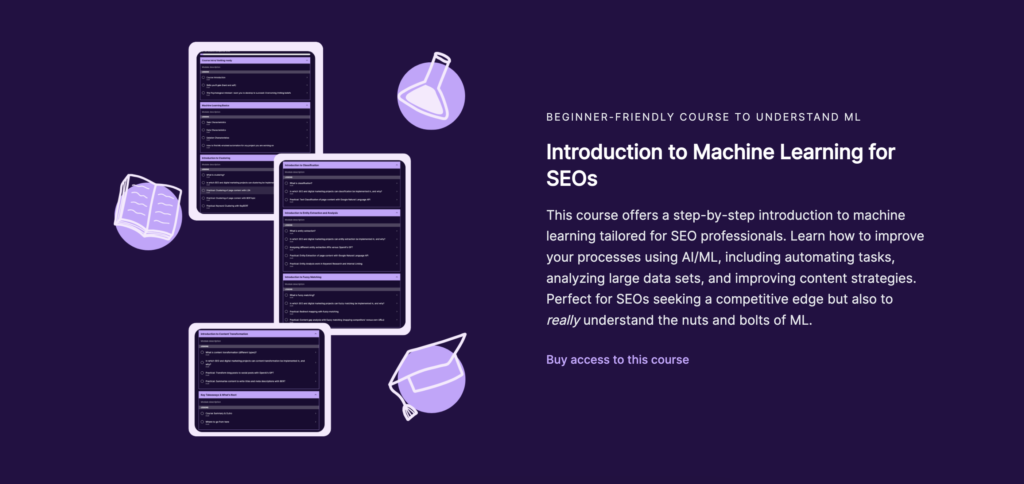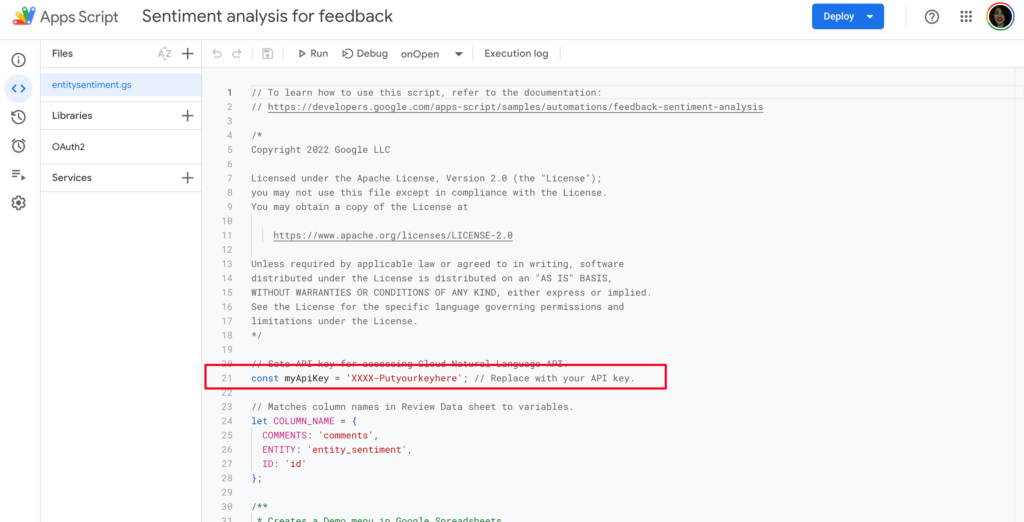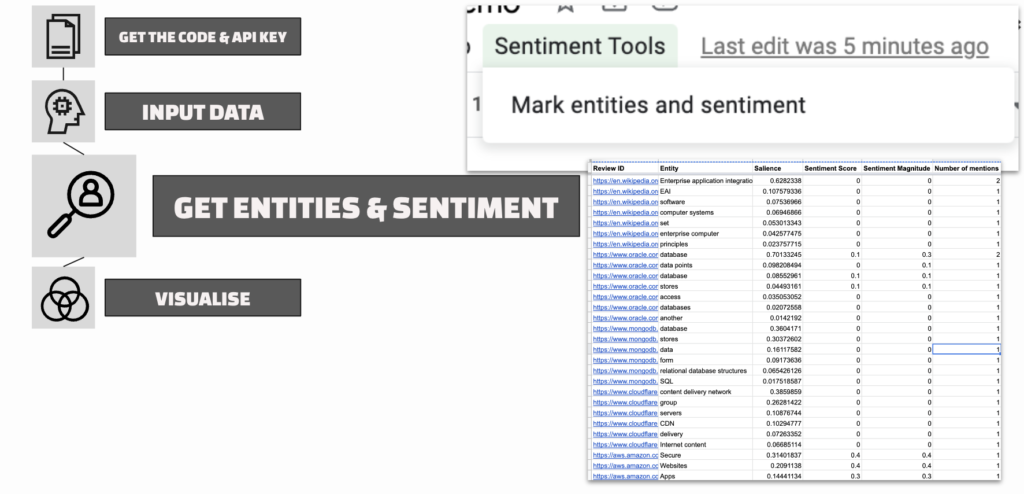Entity analysis is a Machine Learning method that is frequently talked about, but not yet widely used in digital marketing and SEO, despite its many potential application possibilities. In the following guide, I will explore some of the following:
- Why use entity analysis in SEO projects
- How to get started doing entity analysis in Google Sheets (without any coding skills needed)
- Practical projects to implement entity analysis in SEO and how to use it to help formulate strategy
If you’re really serious about your machine learning journey as a search marketer, consider enrolling in my ‘Introduction to Machine Learning for SEOs’ course on the MLforSEO Academy.

Why use entity analysis in digital marketing and SEO projects
Entity analysis is an essential tool for people trying to improve their organic search performance and aiming to deepen their understanding of how specific entities like brands, people, locations, or products are referenced and connected across digital content. By moving beyond surface-level metrics such as keyword count or keyword density, entity analysis offers a comprehensive view of how these entities are interlinked within the web’s vast content landscape.
Through the examination of how entities are mentioned in blog posts, news articles, and online discussions, search marketers can develop a detailed understanding of the web’s narrative around these entities. This understanding can help craft more effective strategies to improve a website’s organic positioning in search results, identify gaps or opportunities in the market, and foresee shifts in industry trends.
For SEO, entity analysis is crucial in deciphering the relevance and relationships of entities within search queries and content. It allows for creating content that is rich in relevant entities and structured in a way that aligns with how search engines understand and connect these entities. This strategic alignment not only boosts content visibility but also enhances the overall relevance and authority of a website, leading to improved search rankings and user engagement.
Before we explore practical applications, let’s first outline how to do entity analysis with Google’s Natural Language AI in Google Sheets.
How to get started doing entity analysis in Google Sheets
Entity analysis with Google’s Natural Language API, is a very beginner-friendly way to get started analyzing entities from short or long-form content without any coding skills required. The procedure requires obtaining an API key and using a Google Sheets template, originally presented at a Cloud Next event in 2018.
To get started, follow these simple steps:

- Click on the Extensions menu from the top then AppScript, then enter your API key in line 21 of the code of the EntitySentiment project. Then click SAVE project

- Return to the sheet. Paste the text you want to analyze the entities from data in column B, and their identifier (URL, ID, or any other, depending on the text you want to analyze) in column A

- click on the “Sentiment Tools” menu and then the button “Mark entities and sentiments”

- Your data will populate the “Entity sentiment data” worksheet and is ready for visualization (check out my Looker Studio dashboard if you need help with the visualization of the data).
This process is straightforward and is the same regardless of how you intend to use the data you get from it, or regardless of what type of text you’re extracting the entities from. Now that that’s out of the way, let’s jump into the practical ways to utilize this data for insights.
With Google’s Natural Language AI, as a result of this analysis you get the following:
- Entity – recognized thing/concept
- Salience – importance of the entity in the context, in which is mentioned
- Sentiment Score – the sentiment score, associated with the context in which the entity is mentioned
- Sentiment Magnitude – the strength of the sentiment score
- # of mentions – entity prominence in the analyzed text (especially important for longer texts)
10 practical ways to implement entity analysis and insights in SEO strategy or digital marketing
Use entity analysis in keyword research
Entity analysis beats traditional keyword strategies by focusing on the context and relationships between words, thereby helping you gain a deeper level of the context and importance of words.
Entity analysis revolves around the concept of identifying and leveraging ‘entities’ – which are distinct, well-defined terms or concepts – within your content strategy. This approach is crucial because search engines like Google are increasingly focusing on understanding searcher intent and the contextual meaning of queries. By incorporating entity analysis, you can align your keyword strategy more closely with how modern search algorithms interpret and categorize content.
Instead of simply building a keyword universe, you should also build an entity universe for your website’s topic, where you delve into your niche topic and identify not just popular keywords, but also the entities that are frequently associated with them. By mapping out these entities and the relationships between entities and how people search (their search patterns, like ngrams), you can create content that is not only rich in relevant keywords but also structured in a way that search engines recognize as authoritative and comprehensive. Having this mapped out can also enable you to plan unique content, and the new information, associated with your target entities, that your content will introduce.
To implement entity analysis in your keyword research, build a keyword universe the traditional way, then use Google’s Natural Language API to help you identify entities within your topic area and understand their relevance and relationship to each other. This can help you see the relationship between particular entities and search volume, as well as search competitiveness. This method is particularly effective for long-tail keyword strategies.
Using your keyword data as a starting point, validate which keywords contain entities. Then:
- Create content maps, based on closely linked entities
- Create lists of positive and negative secondary entities to discuss for content writers
- Create lists of entity attributes to address in the content
- As an additional step, you can also validate which keywords contain entities that are part of Google’s knowledge graph
Use entity analysis in internal link or backlink audits and optimization of site structure
Entity analysis can be great for improving your site architecture, especially in the context of internal link analysis. You can incorporate entity analysis in several different points of your internal link audit or when analyzing your backlinks:
- Extract entities from your internal link anchor text to check whether it is aligned with the topical entity map of your site and the entities your target users search for or talk about online For example, if your website is focused on sustainable living, entity analysis can help you determine if your internal links are consistently emphasizing related entities like ‘eco-friendly products’, ‘sustainable practices’, or ‘green living tips’.
- Extract entities from your backlinks anchor text to check whether your content is being described by third parties in the way that you intend it to be. Are there any repeating entities that describe your content in ways that you would not consider? Are these aligned with the way that your content is intended to be read and understood? If not, perhaps this can indicate the need to rework some aspects of the work.
This approach of analyzing both internal and external links through the lens of entity analysis not only enhances the coherence of your site’s thematic structure but also ensures that the narrative you’re building online is consistent and aligned with your brand’s goals. In a digital environment where relevance and context are king, fine-tuning your site architecture using entity analysis can significantly impact how your content is perceived by users, third-party websites, and search engines.
Use entity analysis to analyze feedback from your customers or users
In my blog post on practical ways to implement sentiment analysis in your digital marketing or SEO strategy, I shared how you can use sentiment analyze customer feedback or user interactions on social media websites and comments. Entity analysis with Google’s Natural Language API can take this analysis a step further, as it can provide a more granular understanding of your customer’s feedback.
Imagine that you not only analyze customer feedback for sentiment polarity – like if a review is positive or negative, but you also go into the nuances of particular aspects of the review that make up the review. If a customer’s review is negative, you’d like to know what aspects of the service or product are the ones that bring the most negative sentiment, and conversely – the aspects of what already works well. For instance, they like the customer service but are unhappy with the pricing structure. This information can be pivotal in addressing their concerns or amplifying to other customers what you are doing well.
Google’s Natural Language API identifies not only entities in the text but also the sentiment and sentiment magnitude, associated with them. The sentiment magnitude feature of the API adds another layer of insight, showing not just whether the sentiment is positive or negative, but also the strength of that sentiment. This helps in prioritizing which issues need immediate attention based on how strongly customers feel about them.
Use the template and process, shown at the start of this blog post, then check if there are entities that are mentioned more times than others, and seek for patterns in the sentiment, with which they are mentioned. You can use this analysis for direct feedback (like customer forms or product reviews) but also for feedback for your company, collected on other platforms (like Trustpilot, Glassdoor, or even Google My Business reviews).
By employing this advanced entity analysis, you can pinpoint the exact features or aspects of your service that are being talked about. This method moves beyond basic sentiment polarity, allowing for a detailed analysis of each aspect of a customer’s review. Such detailed insights are invaluable for product development, customer service improvement, and targeted marketing strategies, ultimately helping businesses better align with their customer’s needs and preferences.
Use entity analysis for content analysis and new content ideation
Entity analysis is a powerful tool not just for keyword research, but also for dissecting and understanding the content structure of large websites. It offers a unique lens through which you can analyze how content is organized, the themes it covers, and the depth of coverage on specific topics. For instance, by conducting entity analysis on a comprehensive blog site, you might discover that certain entities are heavily focused on, while others are only briefly touched upon. This can reveal content gaps or areas that are potentially over-saturated, signaling new content to be created, or content to be subsetted.
Entity analysis can spark ideas for new content. By identifying underrepresented entities within your niche or on your website that are otherwise important to customers or the business messaging, you can uncover opportunities for creating new content that addresses these areas. This approach ensures that your content remains fresh, relevant, and comprehensive. It can also help in differentiating your content from competitors by focusing on unique or emerging entities that have not yet been extensively covered.
Entity analysis can also be used to refine existing content. For example, if entity analysis shows that certain topics are commonly discussed in conjunction with others, but your content only addresses them in isolation, there may be an opportunity to expand or update these pieces to provide a more holistic view.
In practice, tools like Google’s Natural Language API or similar entity analysis tools can automate the process of understanding, or even classifying the content on your website. Starting with your website content (scraped), extract entities from the text, titles, and meta descriptions. If an entity, appears more than a certain number of times on a page over a certain threshold of words, highlight it as the prominent entity for the article. Then ask yourself these questions:
- How many articles with prominent entities have them in the title/meta description
- How many articles with prominent entities have internal links incoming from other articles, where the same entities are mentioned – this can signal internal link opportunities
- Highlight articles that don’t contain any entities, map with traffic – this can signal Content enhancement or content consolidation opportunities
Entity analysis informs your content strategy by revealing key entities and their context, helping identify areas for improvement or new topics, and ensuring alignment with audience interests.
Using entity analysis on platforms like YouTube can transform the way you interpret viewer comments – turning them into a goldmine of customer insight. By analyzing comments on videos or on other social platforms, you can identify key themes and topics that resonate with your audience.
For instance, by analyzing YouTube comments, entity analysis can reveal the most talked-about features of a product review video or the aspects of a tutorial that are most appreciated. These insights are crucial for content creators to tailor their future videos to audience interests, enhancing engagement and viewer satisfaction.
Incorporate entity analysis into competitor analysis and identify content gaps
Consider a scenario where you’re analyzing a competitor’s website. How about five competitors? Speed is of the essence to get ahead of competitors if you’re starting a website’s content from scratch or trying to reverse a traffic drop, and entity analysis allows you to quickly understand what competitor content is about and what the main themes of their website are, allowing you to see whether they heavily focus on certain topics but completely overlook others that are equally relevant to the audience. This gap presents a golden opportunity for your brand to create content that fills this void, thereby capturing a segment of the audience that’s currently underserved.
Before implementing entity analysis, you need to scrape the content of your competitors. Then, Google’s Natural Language API can automatically identify and categorize entities within large volumes of content, giving you a clear picture of the competitive content landscape.
By understanding the entities that your competitors focus on, you can assess whether these align with the interests and needs of your target audience. If there’s a discrepancy, it could indicate that your competitors are missing the mark, providing you with a chance to create more audience-aligned content. This not only gives you an edge in content creation but also ensures that your content strategy is both unique and highly relevant to your audience
Enhance local SEO with geo-specific entities
Incorporating geo-specific entities into your content can significantly improve your local search performance. I’ve discussed in a different blog post the importance of doing intent-driven keyword research for international SEO. By tailoring your content to include local landmarks, events, or terms that only people in local markets use to describe them, or even addressing region-specific issues, you can improve how relevant your travel website is for local markets, for instance. This approach is particularly effective in attracting a regional audience, as it aligns your content with the specific cultural and geographic nuances of your target area.
Use entity analysis for on-page and structured data enhancements
Entity analysis is also great for refining on-page content and enhancing structured data. By understanding and incorporating relevant entities into your website’s content titles, headings, and other page metadata, you can significantly improve how search engines comprehend and rank your pages.
On-page content optimization using entity analysis involves identifying key entities that are central to your content and ensuring they are prominently featured and accurately represented. This goes beyond traditional keyword stuffing; it’s about creating rich, contextually relevant content. For example, if you run or plan the content of a culinary website, entity analysis can be instrumental in identifying a broad range of related entities that extend beyond just recipes and ingredients. It can highlight aspects like cooking techniques, kitchen tools, cultural contexts of various cuisines, and dietary considerations.
Structured data, or schema markup, is another area where entity analysis can have a significant impact. By identifying and tagging entities within your content, you can enhance your structured data, making it easier for search engines to understand the context of your pages. This is particularly beneficial for voice search and featured snippets, where precise entity recognition can influence how your content is displayed in search results.
Finally, entity analysis can be used for topical mapping. This process involves identifying and structuring key entities related to your niche, ensuring that your content comprehensively covers these topics in depth and breadth. By doing so, you establish your site as a go-to resource, demonstrating expertise and authority in your specific field.
A topical entity map helps you visualize the landscape of your domain, showing how different topics and subtopics interconnect and relate to each other. Content that aligns with a well-structured topical entity map is more likely to satisfy user queries comprehensively, leading to better user engagement, longer time on page, and greater satisfaction of your website visitors. These signals are amazing not only for your bottom line but also for signaling to search engines that your website offers a high-quality experience and helpful content.
Building a topical entity map starts with in-depth research into your niche to identify key topics and subtopics relevant to your audience. This involves analyzing your own content, competitor sites, industry forums, and social media to understand the range of subjects covered in your field. Entity analysis tools like Google’s Natural Language API can aid in this process by extracting and categorizing entities from large volumes of text, helping you identify the most prominent and relevant topics.
Once you have a list of key topics, organize them hierarchically to reflect their relationships and relevance – this can also be visualized in a tool like Google Looker Studio, or via a mind map or knowledge graph. The primary topics should represent the core areas of your niche, with secondary and tertiary topics branching out to cover more specific subtopics, but yet remaining relevant to your core entities. Regularly updating this map as trends and audience interests evolve is crucial for maintaining the relevance and authority of your content.
Key Takeaways
Entity analysis is a powerful machine learning approach that can be effectively employed to enhance various aspects of a digital marketing or SEO strategy. Despite there being many ways to get started, one of the easiest for beginners is via the Google Natural Language API in Google Sheets, which requires no coding skills. Once you have the analysis completed, you can incorporate the insights from it into various projects.
Entity analysis in digital marketing enriches keyword research by revealing context and relationships between terms, aiding in content creation. It helps identify gaps in competitive analysis for differentiation opportunities. In on-page SEO and structured data, it ensures content is contextually rich and search engine optimized. For social media, like YouTube comments, it offers insights into audience preferences, influencing content strategy. It enhances local SEO with geo-specific entities and improves website topical authority by creating detailed entity maps, making digital marketing strategies more targeted and effective.


